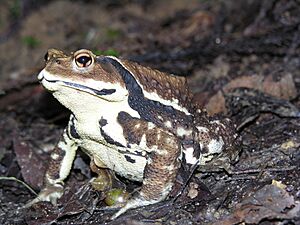Japanese common toad facts for kids
Quick facts for kids Japanese common toad |
|
|---|---|
 |
|
| Conservation status | |
| Scientific classification | |
| Synonyms | |
|
The Japanese common toad (Bufo japonicus) is a type of toad found only in Japan. You might also hear it called the Japanese warty toad or simply the Japanese toad. These toads live in many different places, like forests, swamps, gardens, and even cities. They are often found near ponds or other wet areas.
Contents
What Does It Look Like?
The Japanese common toad can grow to about 17.5 cm (7 in) long from its snout to its tail end. Female toads are usually a bit bigger than males. Toads living in warmer places tend to grow larger than those in colder areas.
Its head is shaped like a triangle with a pointed snout. Behind its eye, there's a part called the tympanum, which is like its eardrum. The toad's body is strong and sturdy. Its front legs are about half the length of its back legs.
The skin of the Japanese common toad has small, warty bumps. Its color can change, appearing greenish-brown, yellowish-brown, or darker brown. During the breeding season, its skin often looks paler and smoother.
Where Do They Live?
The Japanese common toad is originally from Japan. You can find it on the main islands of Honshu, Kyushu, and Shikoku. People have also brought these toads to Hokkaido and Sado Island. They live in many different kinds of places, from lowlands to mountains.
How Do They Live?
Japanese common toads mostly live on land. They eat earthworms and small insects, like ants and some types of beetles. These beetles might be too tough for other animals to eat, but not for the toad!
When winter comes and the temperature drops below about 6 °C (43 °F), these toads go underground to hibernate. This means they go into a deep sleep until it gets warmer again.
Reproduction and Life Cycle
When spring arrives, the Japanese common toads gather in shallow water to breed. The females lay long strings of eggs, which get tangled in plants underwater. These eggs hatch into dark-colored tadpoles.
The tadpoles grow to about 30 or 40 mm (1.2 or 1.6 in) long. By June, they leave the pond as small, young toads.
Male Japanese common toads often compete to mate with females. This is called "explosive breeding" because many toads gather at once. The males will clasp onto the females in a special hug called amplexus. This hug helps the female release her eggs and the male to fertilize them.
Bigger males often have a better chance of mating. They can sometimes replace smaller males during the amplexus hug. This means that the size of the male can be very important in who gets to mate.
Toads travel to their breeding ponds when it's time to reproduce. This journey is a big part of their breeding season. The main steps in their breeding cycle are: waking up from hibernation, migrating to the ponds, the males clasping the females (amplexus), and then the females laying eggs or the males releasing sperm.
Conservation Status
The Japanese common toad lives in many places and can adapt to different environments, even those changed by humans. Scientists believe there are many of these toads, and their numbers are not decreasing much. Because of this, the International Union for Conservation of Nature says their conservation status is "least concern". This means they are not currently in danger of disappearing.
See also


